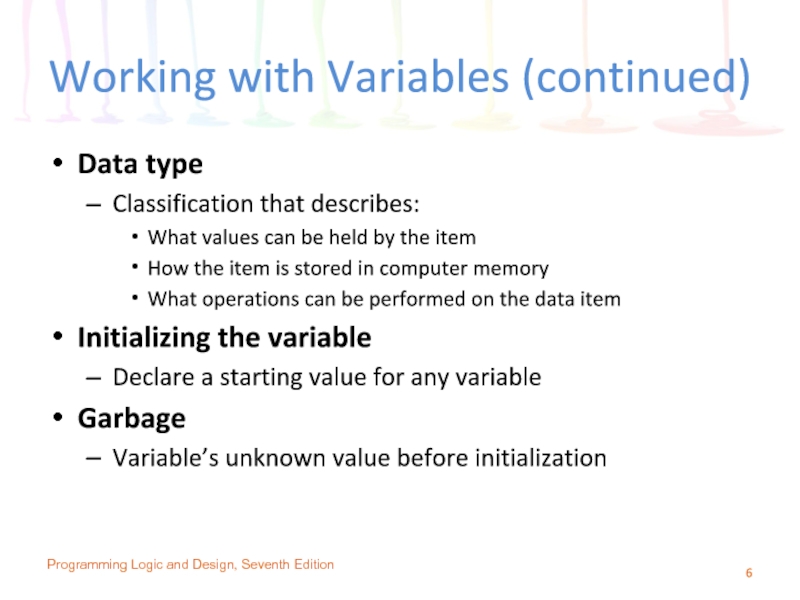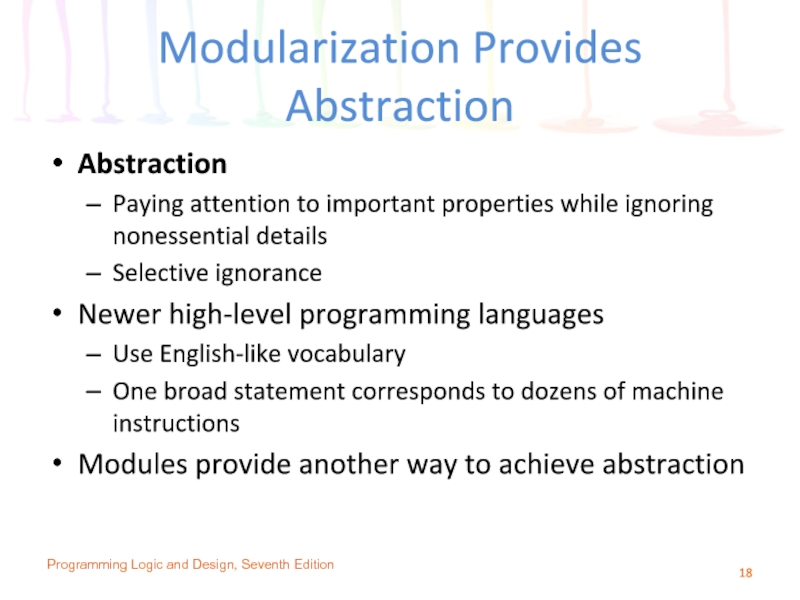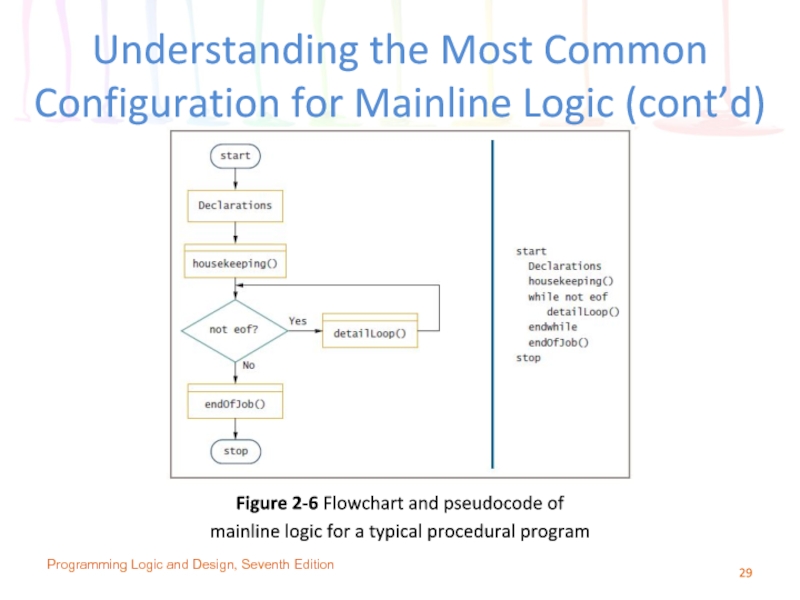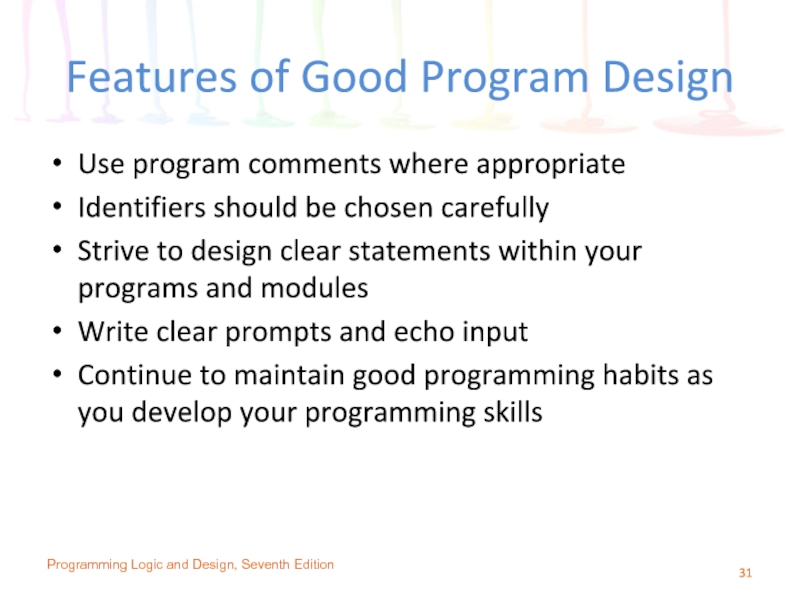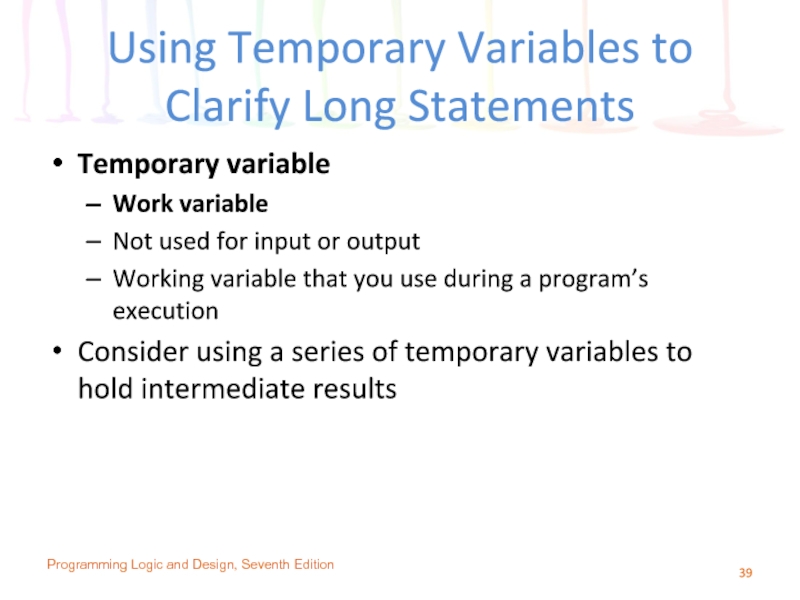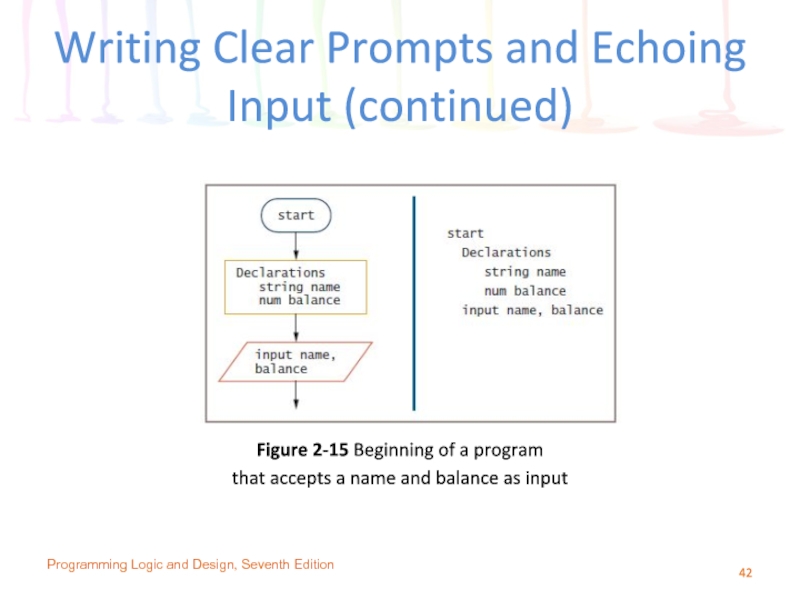- Главная
- Разное
- Дизайн
- Бизнес и предпринимательство
- Аналитика
- Образование
- Развлечения
- Красота и здоровье
- Финансы
- Государство
- Путешествия
- Спорт
- Недвижимость
- Армия
- Графика
- Культурология
- Еда и кулинария
- Лингвистика
- Английский язык
- Астрономия
- Алгебра
- Биология
- География
- Детские презентации
- Информатика
- История
- Литература
- Маркетинг
- Математика
- Медицина
- Менеджмент
- Музыка
- МХК
- Немецкий язык
- ОБЖ
- Обществознание
- Окружающий мир
- Педагогика
- Русский язык
- Технология
- Физика
- Философия
- Химия
- Шаблоны, картинки для презентаций
- Экология
- Экономика
- Юриспруденция
Programming Logic and Design Seventh Edition презентация
Содержание
- 1. Programming Logic and Design Seventh Edition
- 2. Objectives In this chapter, you will learn
- 3. Declaring and Using Variables and Constants Data
- 4. Working with Variables Named memory locations
- 5. Working with Variables (continued) Figure 2-1 Flowchart
- 6. Working with Variables (continued) Data type
- 7. Programming Logic and Design, Seventh Edition
- 8. Naming Variables Programmer chooses reasonable and descriptive
- 9. Naming Variables (continued) Camel casing Variable names
- 10. Assigning Values to Variables Assignment statement set
- 11. Understanding the Data Types of Variables Numeric
- 12. Declaring Named Constants Named constant Similar
- 13. Performing Arithmetic Operations Standard arithmetic operators: +
- 14. Performing Arithmetic Operations (continued) Rules of precedence
- 15. Performing Arithmetic Operations (continued) Left-to-right associativity Operations
- 16. Performing Arithmetic Operations (continued) Table 2-1 Precedence
- 17. Understanding the Advantages of Modularization Modules Subunit
- 18. Modularization Provides Abstraction Abstraction Paying attention
- 19. Modularization Allows Multiple Programmers to Work on
- 20. Modularization Allows You to Reuse Work
- 21. Modularizing a Program Main program Basic steps
- 22. Modularizing a Program (continued) When a main
- 23. Programming Logic and Design, Seventh Edition
- 24. Modularizing a Program (continued) Statements taken out
- 25. Programming Logic and Design, Seventh Edition
- 26. Declaring Variables and Constants within Modules Place
- 27. Declaring Variables and Constants within Modules (continued)
- 28. Understanding the Most Common Configuration for Mainline
- 29. Understanding the Most Common Configuration for Mainline
- 30. Creating Hierarchy Charts Hierarchy chart Shows
- 31. Features of Good Program Design Use program
- 32. Using Program Comments Program comments Written
- 33. Using Program Comments (continued) Programming Logic and
- 34. Programming Logic and Design, Seventh Edition Figure 2-13 Flowchart that includes annotation symbols
- 35. Choosing Identifiers General guidelines Give a variable
- 36. Choosing Identifiers (continued) General guidelines (continued) Use
- 37. Designing Clear Statements Avoid confusing line breaks
- 38. Avoiding Confusing Line Breaks Most modern programming
- 39. Using Temporary Variables to Clarify Long Statements
- 40. Using Temporary Variables to Clarify Long Statements
- 41. Writing Clear Prompts and Echoing Input Prompt
- 42. Writing Clear Prompts and Echoing Input (continued)
- 43. Programming Logic and Design, Seventh Edition
- 44. Maintaining Good Programming Habits Every program you
- 45. Summary Programs contain literals, variables, and named
Слайд 2Objectives
In this chapter, you will learn about:
Declaring and using variables and
Performing arithmetic operations
The advantages of modularization
Modularizing a program
Hierarchy charts
Features of good program design
Programming Logic and Design, Seventh Edition
Слайд 3Declaring and Using Variables
and Constants
Data types
Numeric consists of numbers
String is anything
Different forms
Integers and floating-point numbers
Literal and string constants
Unnamed constants
Programming Logic and Design, Seventh Edition
Слайд 4Working with Variables
Named memory locations
Contents can vary or differ over
Declaration
Statement that provides a data type and an identifier for a variable
Identifier
Variable’s name
Programming Logic and Design, Seventh Edition
Слайд 5Working with Variables (continued)
Figure 2-1 Flowchart and pseudocode for the number-doubling
Programming Logic and Design, Seventh Edition
Слайд 6Working with Variables (continued)
Data type
Classification that describes:
What values can
How the item is stored in computer memory
What operations can be performed on the data item
Initializing the variable
Declare a starting value for any variable
Garbage
Variable’s unknown value before initialization
Programming Logic and Design, Seventh Edition
Слайд 7Programming Logic and Design, Seventh Edition
Figure 2-2 Flowchart and pseudocode of
program with variable declarations
Слайд 8Naming Variables
Programmer chooses reasonable and descriptive names for variables
Programming languages have
Most languages allow letters and digits
Some languages allow hyphens
Reserved keywords are not allowed
Variable names are case sensitive
Programming Logic and Design, Seventh Edition
Слайд 9Naming Variables (continued)
Camel casing
Variable names such as hourlyWage have a “hump”
Be descriptive
Must be one word
Must start with a letter
Should have some appropriate meaning
Programming Logic and Design, Seventh Edition
Слайд 10Assigning Values to Variables
Assignment statement
set myAnswer = myNumber * 2
Assignment operator
Equal
Always operates from right to left
Valid
set someNumber = 2
set someOtherNumber = someNumber
Not valid
set 2 + 4 = someNumber
Programming Logic and Design, Seventh Edition
Слайд 11Understanding the Data Types of Variables
Numeric variable
Holds digits
Can perform
String variable
Can hold text
Letters of the alphabet
Special characters such as punctuation marks
Type-safety
Prevents assigning values of an incorrect data type
Programming Logic and Design, Seventh Edition
Слайд 12Declaring Named Constants
Named constant
Similar to a variable
Can be assigned a
Assign a useful name to a value that will never be changed during a program’s execution
Magic number
Unnamed constant
Use taxAmount = price * SALES_TAX_AMOUNT instead of taxAmount = price * .06
Programming Logic and Design, Seventh Edition
Слайд 13Performing Arithmetic Operations
Standard arithmetic operators:
+ (plus sign)—addition
− (minus sign)—subtraction
* (asterisk)—multiplication
/ (slash)—division
Programming
Слайд 14Performing Arithmetic Operations (continued)
Rules of precedence
Also called the order of operations
Dictate
Expressions within parentheses are evaluated first
Multiplication and division are evaluated next
From left to right
Addition and subtraction are evaluated next
From left to right
Programming Logic and Design, Seventh Edition
Слайд 15Performing Arithmetic Operations (continued)
Left-to-right associativity
Operations with the same precedence take place
Programming Logic and Design, Seventh Edition
Слайд 16Performing Arithmetic Operations (continued)
Table 2-1 Precedence and associativity of five common
Programming Logic and Design, Seventh Edition
Слайд 17Understanding the Advantages
of Modularization
Modules
Subunit of programming problem
Also called subroutines, procedures, functions,
Modularization
Breaking down a large program into modules
Reasons
Abstraction
Allows multiple programmers to work on a problem
Reuse your work more easily
Programming Logic and Design, Seventh Edition
Слайд 18Modularization Provides Abstraction
Abstraction
Paying attention to important properties while ignoring nonessential
Selective ignorance
Newer high-level programming languages
Use English-like vocabulary
One broad statement corresponds to dozens of machine instructions
Modules provide another way to achieve abstraction
Programming Logic and Design, Seventh Edition
Слайд 19Modularization Allows Multiple Programmers to Work on a Problem
Easier to divide
Rarely does a single programmer write a commercial program
Professional software developers can write new programs quickly by dividing large programs into modules
Assign each module to an individual programmer or team
Programming Logic and Design, Seventh Edition
Слайд 20Modularization Allows You to
Reuse Work
Reusability
Feature of modular programs
Allows individual modules
Many real-world examples of reusability
Reliability
Assures that a module has been tested and proven to function correctly
Programming Logic and Design, Seventh Edition
Слайд 21Modularizing a Program
Main program
Basic steps (mainline logic) of the program
Include in
Module header
Module body
Module return statement
Naming a module
Similar to naming a variable
Module names are followed by a set of parentheses
Programming Logic and Design, Seventh Edition
Слайд 22Modularizing a Program (continued)
When a main program wants to use a
“Calls” the module’s name
Flowchart
Symbol used to call a module is a rectangle with a bar across the top
Place the name of the module you are calling inside the rectangle
Draw each module separately with its own sentinel symbols
Programming Logic and Design, Seventh Edition
Слайд 23Programming Logic and Design, Seventh Edition
Figure 2-3 Program that produces a
Слайд 24Modularizing a Program (continued)
Statements taken out of a main program and
Main program becomes shorter and easier to understand
Modules are reusable
When statements contribute to the same job, we get greater functional cohesion
Programming Logic and Design, Seventh Edition
Слайд 25Programming Logic and Design, Seventh Edition
Figure 2-5 The billing program with
Слайд 26Declaring Variables and Constants
within Modules
Place any statements within modules
Input, processing, and
Variable and constant declarations
Variables and constants declared in a module are usable only within the module
Visible
In scope, also called local
Portable
Self-contained units that are easily transported
Programming Logic and Design, Seventh Edition
Слайд 27Declaring Variables and Constants
within Modules (continued)
Global variables and constants
Declared at
Visible to and usable in all the modules called by the program
Many programmers avoid global variables to minimize errors
Programming Logic and Design, Seventh Edition
Слайд 28Understanding the Most Common
Configuration for Mainline Logic
Mainline logic of almost every
Declarations for global variables and constants
Housekeeping tasks
Detail loop tasks
End-of-job tasks
Programming Logic and Design, Seventh Edition
Слайд 29Understanding the Most Common
Configuration for Mainline Logic (cont’d)
Figure 2-6 Flowchart and
mainline logic for a typical procedural program
Programming Logic and Design, Seventh Edition
Слайд 30Creating Hierarchy Charts
Hierarchy chart
Shows the overall picture of how modules
Tells you which modules exist within a program and which modules call others
Specific module may be called from several locations within a program
Planning tool
Develop the overall relationship of program modules before you write them
Documentation tool
Programming Logic and Design, Seventh Edition
Слайд 31Features of Good Program Design
Use program comments where appropriate
Identifiers should be
Strive to design clear statements within your programs and modules
Write clear prompts and echo input
Continue to maintain good programming habits as you develop your programming skills
Programming Logic and Design, Seventh Edition
Слайд 32Using Program Comments
Program comments
Written explanations of programming statements
Not part of
Serve as documentation for readers of the program
Syntax used differs among programming languages
Flowchart
Use an annotation symbol to hold information that expands on what is stored within another flowchart symbol
Programming Logic and Design, Seventh Edition
Слайд 33Using Program Comments (continued)
Programming Logic and Design, Seventh Edition
Figure 2-12 Pseudocode
Слайд 34Programming Logic and Design, Seventh Edition
Figure 2-13 Flowchart that includes annotation
Слайд 35Choosing Identifiers
General guidelines
Give a variable or a constant a name that
Give a module an identifier that is a verb (because it performs an action)
Use meaningful names
Self-documenting
Use pronounceable names
Be judicious in your use of abbreviations
Avoid digits in a name
Programming Logic and Design, Seventh Edition
Слайд 36Choosing Identifiers (continued)
General guidelines (continued)
Use the system your language allows to
Consider including a form of the verb to be
Name constants using all uppercase letters separated by underscores (_)
Programmers create a list of all variables
Data dictionary
Programming Logic and Design, Seventh Edition
Слайд 37Designing Clear Statements
Avoid confusing line breaks
Use temporary variables to clarify long
Programming Logic and Design, Seventh Edition
Слайд 38Avoiding Confusing Line Breaks
Most modern programming languages are
free-form
Make sure your
Do not combine multiple statements on one line
Programming Logic and Design, Seventh Edition
Слайд 39Using Temporary Variables to Clarify Long Statements
Temporary variable
Work variable
Not used
Working variable that you use during a program’s execution
Consider using a series of temporary variables to hold intermediate results
Programming Logic and Design, Seventh Edition
Слайд 40Using Temporary Variables to Clarify Long Statements (continued)
Figure 2-14 Two ways
Programming Logic and Design, Seventh Edition
Слайд 41Writing Clear Prompts and Echoing Input
Prompt
Message displayed on a monitor
Used both in command-line and GUI interactive programs
Echoing input
Repeating input back to a user either in a subsequent prompt or in output
Programming Logic and Design, Seventh Edition
Слайд 42Writing Clear Prompts and Echoing Input (continued)
Figure 2-15 Beginning of a
that accepts a name and balance as input
Programming Logic and Design, Seventh Edition
Слайд 43Programming Logic and Design, Seventh Edition
Figure 2-16 Beginning of a program
name and balance as input and uses a separate prompt for each item
Слайд 44Maintaining Good Programming Habits
Every program you write will be better if
Plan before you code
Maintain the habit of first drawing flowcharts or writing pseudocode
Desk-check your program logic on paper
Think carefully about the variable and module names you use
Design your program statements to be easy to read and use
Programming Logic and Design, Seventh Edition
Слайд 45Summary
Programs contain literals, variables, and named constants
Arithmetic follows rules of precedence
Break
Include a header, a body, and a return statement
Hierarchy charts show relationship among modules
As programs become more complicated:
Need for good planning and design increases
Programming Logic and Design, Seventh Edition





